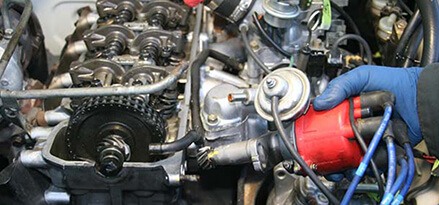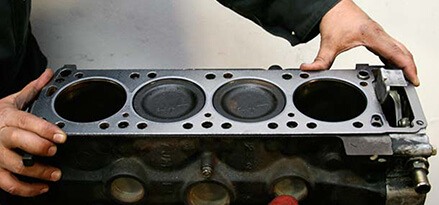By Mike Bumbeck, automedia.com
Difficulty: Difficult
Estimated time: 300 minutes
Understanding why a relatively inexpensive head gasket costs so much to replace means first realizing what it sits between. In the engine block are pistons that travel up and down in cylinder bores. The pistons are connected to rods, which in turn are connected to a spinning crankshaft from which the vehicle takes its power. Bolted to the top of the engine is the cylinder head. Inside the cylinder head are valves that open and close to let air and fuel into the cylinders and expel the spent exhaust gas.
The head gasket is compressed between the engine block and the cylinder head. The head gasket seals in the internal combustion process and also keeps coolant and oil from mixing together as the two fluids travel from the engine block to the cylinder head. Head gaskets themselves are not very expensive. What ends up costing big money is getting to it. Head gasket repairs mean undertaking the major operation of removing an engine's head.
Boiling over
A head gasket can fail for a number of reasons, none of them good. Engine
overheating is the most popular culprit. The metal of the engine block and
head expands beyond limits during overheating. This expansion can pinch the
head gasket to the point where it will fail. The next major causes of head
gasket failure are engine pre-ignition or detonation. The crux of these two
conditions is out-of-time combustion occurring in the cylinders. Internal
combustion is supposed to occur with both valves closed and with the piston
at the top of its power stroke. Out-of-time combustion puts extra strain on
the valves, pistons and head gasket. Ironically, engine overheating can
also increase the likelihood of pre-ignition and detonation. The sound of
an engine pinging or knocking is the insidious sound of damage.
Replacing a head gasket
Head gasket replacement is not a job for the average do-it-yourselfer.
While a head gasket expiring due to old age is rare, it usually means
everything else is worn out to the point of replacement as well. Cracking
the head off the engine and peering inside may reveal that everything else
got fully cooked, too. The best way to prevent head gasket failure is to
keep the cooling system in top working order and make sure the engine is in
tune and running correctly. The failure of a $5 thermostat or $3 coolant
hose can cause thousands of dollars in engine damage in a hurry.
How-to tips
The following are a few general tips to changing a head gasket. For
vehicle-specific head gasket replacement procedures, always consult a
service manual.

Step 1: Getting down to the head gasket can be an involved process. Always mark and index everything before removal. In this case, it was easier to remove the exhaust manifold, head and intake as a unit. A service manual is the first and most important tool in the toolbox.

Step 2: Check the head and block for flatness. A machined straight edge across the surface and feeler gauge will reveal all. The service manual will provide specifications. Blocks or heads out of specification must be sent out to the machine shop and be repaired. The machine shop will also be able to check for cracks.

Step 3: Prepare the surface. Never use anything that will remove metal. Be careful not to scratch the deck of the block or mounting surface of the head. While it may seem like a good idea to use a scrubber pad connected to a power tool, the surface irregularities created can cause sealing problems down the road.

Step 4: Chase the head bolt or stud holes with a tap or thread chaser to remove any crud and prepare the threads. Use compressed air to blow out any stragglers. Correct head bolt torque is of the utmost importance. Any interference can throw off the torque readings.

Step 5: Prefit the head gasket in the correct orientation. Never use sealant unless specifically required by the manufacturer. Head gaskets that require sealant will usually come so equipped. The service manual will outline sealant locations and requirements.

Step 6: Correct bolt tightening sequence and torque is key to proper head gasket sealing. Use new bolts if required. Coat head bolt threads with some engine oil before installing. Always follow tightening sequence and torque instructions to the last detail.
Discover the different types of oil filters and how they work

